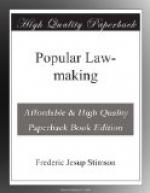Now, this tremendous increase in legislative output, most notable in the States of the United States, did not begin with us at once. For some forty or fifty years after the Revolution our State legislatures made as little constructive legislation as did the Parliament of George III. It was with the end of the first quarter of the nineteenth century that the great increase began. It seems to have taken democratic legislatures some fifty years to become conscious that they had this new unlimited power, and not only that they possessed it but were expected to exercise it; the power of making absolutely new laws, statutes which did not exist before as law, either by the common law or by the custom of the people. It is true, our ancestors had some taste of radical legislation during the Revolution, and the checks of the State constitutions were adopted for that reason; but subject only to this limitation, it was the first modern experiment in popular legislation. The great wave of radical law-making that began with the moral movements—the prohibition movement, the anti-slavery movement, and the women’s rights movement—of the second quarter of the nineteenth century, lasted down until the Civil War. After that there was a conservative reaction, followed by a new radical wave in reconstruction times, which ended with another conservative reaction at the time of the first election of President Cleveland. Since then, new moral or social movements, mainly those concerned with the desire to benefit labor and repress the trusts, with the desire to protect women and children, seem to have brought up a new radical wave, the progress of which has hardly ended yet. Before the Civil War, the women’s rights movement and the anti-slavery movement always worked together. They were in great part composed of the same persons. In fact, the historical origin of the women’s suffrage movement was a large abolition meeting held in England, but attended by many women delegates from America, where they excluded a leading American woman abolitionist and would only allow her husband to take her seat in her place. We shall, of course, consider this precise question later, and pause now merely to note the fact that with the anti-slavery movement, ending with the adoption of the war amendments and the women’s suffrage movement, ceasing to progress soon after, there came the period of conservative reaction, or, at least, of quiescence, which lasted down to the recent labor and social movements that have caused our increasing mass of constructive legislation in the last few years. It is true that some of the far Western Territories adopted women’s suffrage soon after being made States, or at the time they were admitted; but no other State, even of those surrounding them, has followed their example, though the people have repeatedly voted on the point. Whatever progress the cause may have made in England, or in the larger cities of the East, I think that no unprejudiced observer would say that it looks so




